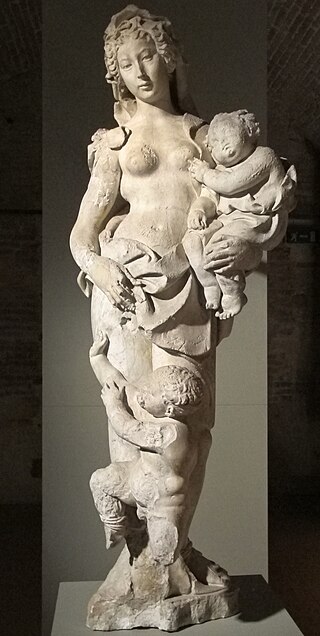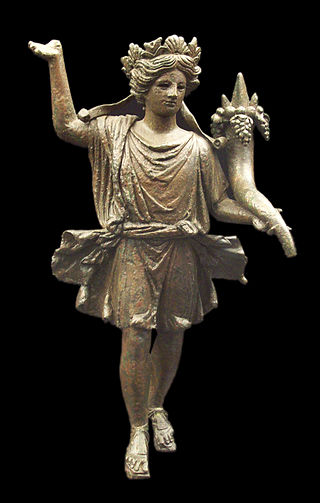Related Research Articles

In ancient Greek religion and mythology, Artemis is the goddess of the hunt, the wilderness, wild animals, nature, vegetation, childbirth, care of children, and chastity. In later times, she was identified with Selene, the personification of the Moon. She was often said to roam the forests and mountains, attended by her entourage of nymphs. The goddess Diana is her Roman equivalent.

Diana is a goddess in Roman and Hellenistic religion, primarily considered a patroness of the countryside and nature, hunters, wildlife, childbirth, crossroads, the night, and the Moon. She is equated with the Greek goddess Artemis, and absorbed much of Artemis' mythology early in Roman history, including a birth on the island of Delos to parents Jupiter and Latona, and a twin brother, Apollo, though she had an independent origin in Italy.
Hecate is a goddess in ancient Greek religion and mythology, most often shown holding a pair of torches, a key, or snakes, or accompanied by dogs, and in later periods depicted as three-formed or triple-bodied. She is variously associated with crossroads, entrance-ways, night, light, magic, witchcraft, the Moon, knowledge of herbs and poisonous plants, graves, ghosts, necromancy, and sorcery. Her earliest appearance in literature was in Hesiod's Theogony in the 8th century BCE as a goddess of great honour with domains in sky, earth, and sea. Her place of origin is debated by scholars, but she had popular followings amongst the witches of Thessaly and an important sanctuary among the Carian Greeks of Asia Minor in Lagina. Her oldest known representation was found in Selinunte, in Sicily.

Vesta is the virgin goddess of the hearth, home, and family in Roman religion. She was rarely depicted in human form, and was more often represented by the fire of her temple in the Forum Romanum. Entry to her temple was permitted only to her priestesses, the Vestal Virgins, who guarded particular sacred objects within, prepared flour and sacred salt for official sacrifices, and tended Vesta's sacred fire at the temple hearth. Their virginity was thought essential to Rome's survival; if found guilty of inchastity, they were buried or entombed alive. As Vesta was considered a guardian of the Roman people, her festival, the Vestalia, was regarded as one of the most important Roman holidays. During the Vestalia privileged matrons walked barefoot through the city to the temple, where they presented food-offerings. Such was Vesta's importance to Roman religion that following the rise of Christianity, hers was one of the last non-Christian cults still active, until it was forcibly disbanded by the Christian emperor Theodosius I in AD 391.

Eileithyia or Ilithyia was the Greek goddess of childbirth and midwifery, and the daughter of Zeus and Hera. In the cave of Amnisos (Crete) she was related with the annual birth of the divine child, and her cult is connected with Enesidaon, who was the chthonic aspect of the god Poseidon. It is possible that her cult is related with the cult of Eleusis. In his Seventh Nemean Ode, Pindar refers to her as the maid to or seated beside the Moirai (Fates) and responsible for the creation of offspring. Her son was Sosipolis, who was worshiped at Elis.

In Greek mythology, Galanthis or Galinthias was the woman who interfered with Hera's plan to hinder the birth of Heracles in favor of Eurystheus, and was changed into a weasel or cat as punishment for being so insolent as to deceive the goddesses of birth that were acting on Hera's behalf.

In Sabine and ancient Roman religion and myth, Luna is the divine embodiment of the Moon. She is often presented as the female complement of the Sun, Sol, conceived of as a god. Luna is also sometimes represented as an aspect of the Roman triple goddess, along with Diana and either Proserpina or Hecate. Luna is not always a distinct goddess, but sometimes rather an epithet that specializes a goddess, since both Diana and Juno are identified as moon goddesses.

Acca Larentia or Acca Larentina was a mythical woman, later a goddess of fertility, in Roman mythology whose festival, the Larentalia, was celebrated on December 23.

The Sabines (, SAY-bynes,, SAB-eyens; Latin: Sabini; Italian: Sabini; Greek: Σαβίνοι Sabinoi, were an Italic people who lived in the central Apennine Mountains of the ancient Italian Peninsula, also inhabiting Latium north of the Anio before the founding of Rome.
Agis II was the 18th Eurypontid king of Sparta, the eldest son of Archidamus II by his first wife, and half-brother of Agesilaus II. He ruled with his Agiad co-monarch Pausanias.

Juno was an ancient Roman goddess, the protector and special counsellor of the state. She was equated to Hera, queen of the gods in Greek mythology and a goddess of love and marriage. A daughter of Saturn and Ops, she was the sister and wife of Jupiter and the mother of Mars, Vulcan, Bellona, Lucina and Juventas. Like Hera, her sacred animal was the peacock. Her Etruscan counterpart was Uni, and she was said to also watch over the women of Rome. As the patron goddess of Rome and the Roman Empire, Juno was called Regina ("Queen") and was a member of the Capitoline Triad, centered on the Capitoline Hill in Rome, and also including Jupiter, and Minerva, goddess of wisdom.
The Secular Games was a Roman religious celebration (Ludi) involving sacrifices and theatrical performances held in ancient Rome for three days and nights to mark the end of a saeculum and the beginning of the next. A saeculum, supposedly the longest possible length of human life, was considered as either 100 or 110 years in length.

Lares were guardian deities in ancient Roman religion. Their origin is uncertain; they may have been hero-ancestors, guardians of the hearth, fields, boundaries, or fruitfulness, or an amalgam of these.

Vulcan is the god of fire including the fire of volcanoes, deserts, metalworking and the forge in ancient Roman religion and myth. He is often depicted with a blacksmith's hammer. The Vulcanalia was the annual festival held August 23 in his honor. His Greek counterpart is Hephaestus, the god of fire and smithery. In Etruscan religion, he is identified with Sethlans.

The Vinalia were Roman festivals of the wine harvest, wine vintage and gardens, held in honour of Jupiter and Venus. The Vinalia prima, also known as the Vinalia urbana was held on 23 April to bless and sample last year's wine and ask for good weather until the next harvest. The Vinalia rustica was on 19 August, before the harvest and grape-pressing.

The di inferi or dii inferi were a shadowy collective of ancient Roman deities associated with death and the underworld. The epithet inferi is also given to the mysterious Manes, a collective of ancestral spirits. The most likely origin of the word Manes is from manus or manis, meaning "good" or "kindly," which was a euphemistic way to speak of the inferi so as to avert their potential to harm or cause fear.

In ancient Roman religion, the October Horse was an animal sacrifice to Mars carried out on October 15, coinciding with the end of the agricultural and military campaigning season. The rite took place during one of three horse-racing festivals held in honor of Mars, the others being the two Equirria on February 27 and March 14.

The supplicia canum was an annual sacrifice of ancient Roman religion in which live dogs were suspended from a furca ("fork") or cross (crux) and paraded. It appears on none of the extant Roman calendars, but a late source places it on August 3 (III Non. Aug.).
References
- ↑ Pliny, Natural History 29.58: Genitae Manae catulo res divina fit.
- ↑ Plutarch, Roman questions, n°52
- ↑ Festus, "The origin of words", article Maniae
- ↑ Varro, "De lingua latina", book IX, 60-62
- ↑ about this hint, refer to Rose, The Roman Questions of Plutarch, p. 142 online.
- ↑ about that hint see Simon Goldhill, Being Greek Under Rome: Cultural Identity, the Second Sophistic and the Development of Empire (Cambridge University Press, 2007), pp. 106–107.
- ↑ H.J. Rose, The Roman Questions of Plutarch (Oxford: Clarendon Press, 1924, 1974), p. 192, note LII; David and Noelle Soren, A Roman Villa and a Late Roman Infant Cemetery («L'Erma» di Bretschneider, 1999), p. 520 online.; Plutarch actually tries some cunning writing mixing the dual connotation of Mana, that he relates to death, and Genita, that he quite as obviously relates to birth
- ↑ Emily A McDermott, "Greek and Roman Elements in Horace's Lyric Program," Aufsteig under Niedergang der römischen Welt (1981), p. 1665; other views refer Genitalis to e.g. Juno
- ↑ Rose, The Roman Questions of Plutarch, p. 192.
- ↑ Loeb Classical Library translation, Bill Thayer's edition at LacusCurtius online.